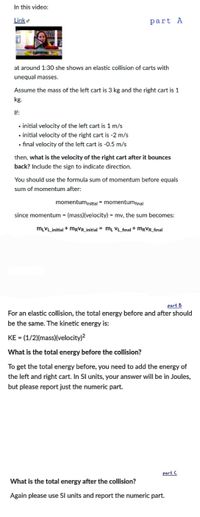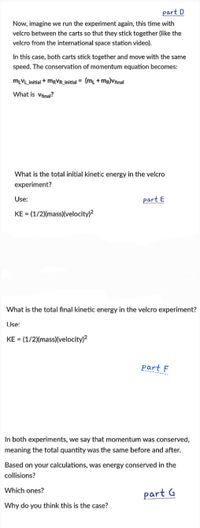Question
The class I'm taking is physics for scientists and engineers!
I am completely stuck. Need help. I have attached the problem. Please view both attachments before answering.
*****I need help with parts D , E , F and G please. ******
I have also attached the links to BOTH videos below. If you can please explain your answer so I can fully understand. Thank you so much!
Link: https://youtu.be/eK7dMnnElx8
Link: https://youtu.be/4IYDb6K5UF8

Transcribed Image Text:In this video:
Link e
part A
at around 1:30 she shows an elastic collision of carts with
unequal masses.
Assume the mass of the left cart is 3 kg and the right cart is 1
kg.
If:
• initial velocity of the left cart is 1 m/s
• initial velocity of the right cart is -2 m/s
• final velocity of the left cart is -0.5 m/s
then, what is the velocity of the right cart after it bounces
back? Include the sign to indicate direction.
You should use the formula sum of momentum before equals
sum of momentum after:
momentuminitial = momentumfinal
since momentum = (mass)(velocity) = mv, the sum becomes:
mLVL_initial + MRVR_initial = mL VL_final + MRVR_final
part B
For an elastic collision, the total energy before and after should
be the same. The kinetic energy is:
KE = (1/2)(mass)(velocity)?
What is the total energy before the collision?
To get the total energy before, you need to add the energy of
the left and right cart. In SI units, your answer will be in Joules,
but please report just the numeric part.
part C
What is the total energy after the collision?
Again please use Sl units and report the numeric part.

Transcribed Image Text:part D
Now, imagine we run the experiment again, this time with
velcro between the carts so that they stick together (like the
velcro from the international space station video).
In this case, both carts stick together and move with the same
speed. The conservation of momentum equation becomes:
MLVL_initial + MRVR_initial = (ml +mr)Vfinal
What is Vfinal?
What is the total initial kinetic energy in the velcro
experiment?
Use:
part E
KE = (1/2)(mass)(velocity)2
What is the total final kinetic energy in the velcro experiment?
Use:
KE = (1/2)(mass)(velocity)?
part F
In both experiments, we say that momentum was conserved,
meaning the total quantity was the same before and after.
Based on your calculations, was energy conserved in the
collisions?
Which ones?
part G
Why do you think this is the case?
Expert Solution
This question has been solved!
Explore an expertly crafted, step-by-step solution for a thorough understanding of key concepts.
Step by stepSolved in 4 steps

Knowledge Booster
Similar questions
- please answer a, b, and carrow_forwardFree answer instructions: 1. At the top of the page write your name and problem version (A, B, or C) 2. Carefully read the problem 3. Write your solution to each sub-section separately (A, B, C) on paper Your solution can be turned in two ways: A. Scan or take a photo of your solution - make sure your scan is legible Make sure your file is in jpeg or pdf format (other formats will need to be converted). Upload your scanned solution using the "Choose a File" button beneath B. Turn in a hard-copy with your name on it to SRTC 134 by 12:45PM Version B A large disc-shaped grindstone is spinning at 500 revolutions/min. The grindstone has a mass 4.0 kg and radius 9.0 cm. The moment of inertia of a disc rotating about its center is given by I = MR² The power is shut off by the operator and to slow it down, she sharpens a 4 kg axe by holding it against the grindstone until it stops 7 s later. Assume the angular acceleration is constant while the grindstone is slowing down. (A) Draw a diagram…arrow_forwardI need help on this. Please show workarrow_forward
- Please type out your Solutions I have bad eyesight and I have a hard time reading handwriting especially cursive please write out your Solutions and the most easy to understand and simplest way thank you very much I appreciate your helparrow_forwardFree answer instructions: 1. At the top of the page write your name and problem version (A, B, or C) 2. Carefully read the problem 3. Write your solution to each sub-section separately (A, B, C) on paper Your solution can be turned in two ways: A. Scan or take a photo of your solution - make sure your scan is legible Make sure your file is in jpeg or pdf format (other formats will need to be converted). Upload your scanned solution using the "Choose a File" button beneath B. Turn in a hard-copy with your name on it to SRTC 134 by 12:45PM Version A In a General Physics laboratory at Portland State, a block of mass m₁ is sliding along a near frictionless surface with initial velocity of V₁; and has a head-on elastic collision with a stationary block of mass m2. After the collision the blocks have velocities v₁fand v2f. Both masses are measured prior to the experiment and the initial speed of m₁ is also measured using a photo-gate instrument. (A) What equations from conservation are…arrow_forwardKindly provide the solution to the following question using the GRASS method. Motion and Forces (Dynamics Unit). Please show all your work. Other image attached are the formulas for this unit.arrow_forward
- SOLVE STEP BY STEP IN DIGITAL FORMAT DO NOT USE ARTIFICIAL INTELLIGENCE OR CHATGPT, YOU ARE MANY TIMES WRONG THANK YOU VERY MUCH FOR YOUR TIME, YOUR DEDICATION AND RESPONSE I LOVE THEM VERY MUCH A sphere of mass M and radius R is supported by a rope so that the rope is oriented tangent to the sphere. If the angle between the rope and the wall is *? What is the minimum static coefficient of friction between the sphere and the wall so that it does not fall?arrow_forwardWhich if any of these students do you agree with ? Please explain your reasoning. For the first onearrow_forward
arrow_back_ios
arrow_forward_ios